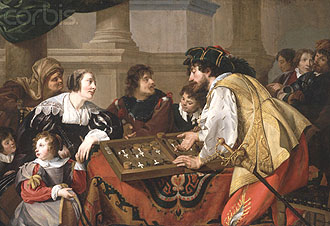|
| Magriel's NYT Columns |
 Outside of tournament play, the strongest backgammon games anywhere are likely to be found at New York’s Mayfair Club. The Mayfair Club, at 220 East 57th Street, was established more than 50 years ago as a bridge club, but in recent years the main focus of activity has been backgammon. Under the direction of Alvin Roth, it has become a training ground for new and improving players to sharpen their skills.
Outside of tournament play, the strongest backgammon games anywhere are likely to be found at New York’s Mayfair Club. The Mayfair Club, at 220 East 57th Street, was established more than 50 years ago as a bridge club, but in recent years the main focus of activity has been backgammon. Under the direction of Alvin Roth, it has become a training ground for new and improving players to sharpen their skills.
The diagrammed position occurred at the Mayfair last week in one of the regular Sunday afternoon chouettes (partnership game). Earlier in the game, White had doubled, and all the Black team players except for the captain had wisely passed. Black realized that with three men stuck behind White’s full prime (from the 22-point to the 17-point) he had little chance of winning. Nevertheless, Black, who was not one to give up easily, searched for a winning method.
|
| Black to play 2-1. |
Fortunately, however, Black came to his senses before making this suicidal play. Because Black’s home board had already collapsed, Black would have no realistic chance of winning, even if he did somehow manage to make both the 23- and 24-points. Indeed, the probable outcome of this play would be to lose a gammon (double game) as a direct result of having additional men sent back. Black is a strong favorite to save the gammon with three men back on an anchor in White’s home board; with four or more men back, Black is quite likely to be gammoned.
In the actual game, Black, resigned to losing, played bar/23, 24/23, making the 23-point in front of White’s prime. This natural and seemingly conservative play actually exposed him to just what he wished to avoid — losing a double game. Against less experienced opposition, the weakness of this play might well have gone unnoticed. White, however, had recently been gammoned himself in a similar position and knew how to exploit Black’s mistake.
White next rolled 3-2 and played 17/19, 17/20, voluntarily breaking his prime in order to let Black out with 6’s. Black then rolled an inconsequential 4-3, with which he cleared his 5-point. On his subsequent turn, he rolled 6-3 and was compelled to play 23/14(2), giving up his anchor on the 23-point. This left Black totally defenseless, with all three of his back men open. White ruthlessly attacked Black, closed out all three men, and easily gammoned Black.
Black could have avoided this sequence by correctly playing bar/24, 3/1. Black must anticipate the possibility that White will attempt to “trap” him off his anchor. By putting all three men firmly on the 24-point, Black avoids any possibility of being closed out, and so minimizes his chance of losing a gammon.
Rollout
 Tom Keith 2013 |
|
Money play Black owns 2-cube Black rolls 2-1 1296 games with VR Checker play: XG Roller Cube play: XG Roller |
| 2-1: | Game | G | BG | Equity | ||||
| 1 | bar/23, 24/23 |
W L |
.0489 .9511 |
.0020 .3581 |
.0000 .0228 | −1.2660 |

| (a) |
| 2 | bar/24, 3/1 |
W L |
.0273 .9727 |
.0004 .3899 |
.0000 .0211 | −1.3483 | (0.0823) | (b) |
Rollout
 Tom Keith 2013 |
|
Money play Black owns 2-cube White rolls 3-2 1296 games with VR Checker play: 2-ply Cube play: 3-ply Red |
| 3-2: | Game | G | BG | Equity | ||||
| 1 | 8/6, 8/5 |
W L |
.9494 .0506 |
.3806 .0021 |
.0247 .0000 | +1.2870 |

| |
| 9 | 21/16 |
W L |
.9508 .0492 |
.3023 .0013 |
.0145 .0000 | +1.2016 | (0.0854) |

|
|

